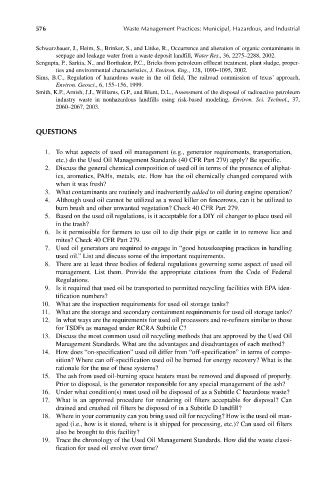Page 605 - Materials Chemistry, Second Edition
P. 605
CAT3525_C19.qxd 1/28/2005 5:05 PM Page 576
576 Waste Management Practices: Municipal, Hazardous, and Industrial
Schwarzbauer, J., Heim, S., Brinker, S., and Littke, R., Occurrence and alteration of organic contaminants in
seepage and leakage water from a waste deposit landfill, Water Res., 36, 2275–2288, 2002.
Sengupta, P., Sarkia, N., and Borthakur, P.C., Bricks from petroleum effluent treatment, plant sludge, proper-
ties and environmental characteristics, J. Environ. Eng., 128, 1090–1095, 2002.
Sims, B.C., Regulation of hazardous waste in the oil field, The railroad commission of texas’ approach,
Environ. Geosci., 6, 155–156, 1999.
Smith, K.P., Arnish, J.J., Williams, G.P., and Blunt, D.L., Assessment of the disposal of radioactive petroleum
industry waste in nonhazardous landfills using risk-based modeling, Environ. Sci. Technol., 37,
2060–2067, 2003.
QUESTIONS
1. To what aspects of used oil management (e.g., generator requirements, transportation,
etc.) do the Used Oil Management Standards (40 CFR Part 279) apply? Be specific.
2. Discuss the general chemical composition of used oil in terms of the presence of aliphat-
ics, aromatics, PAHs, metals, etc. How has the oil chemically changed compared with
when it was fresh?
3. What contaminants are routinely and inadvertently added to oil during engine operation?
4. Although used oil cannot be utilized as a weed killer on fencerows, can it be utilized to
burn brush and other unwanted vegetation? Check 40 CFR Part 279.
5. Based on the used oil regulations, is it acceptable for a DIY oil changer to place used oil
in the trash?
6. Is it permissible for farmers to use oil to dip their pigs or cattle in to remove lice and
mites? Check 40 CFR Part 279.
7. Used oil generators are required to engage in “good housekeeping practices in handling
used oil.” List and discuss some of the important requirements.
8. There are at least three bodies of federal regulations governing some aspect of used oil
management. List them. Provide the appropriate citations from the Code of Federal
Regulations.
9. Is it required that used oil be transported to permitted recycling facilities with EPA iden-
tification numbers?
10. What are the inspection requirements for used oil storage tanks?
11. What are the storage and secondary containment requirements for used oil storage tanks?
12. In what ways are the requirements for used oil processors and re-refiners similar to those
for TSDFs as managed under RCRA Subtitle C?
13. Discuss the most common used oil recycling methods that are approved by the Used Oil
Management Standards. What are the advantages and disadvantages of each method?
14. How does “on-specification” used oil differ from “off-specification” in terms of compo-
sition? Where can off-specification used oil be burned for energy recovery? What is the
rationale for the use of these systems?
15. The ash from used oil-burning space heaters must be removed and disposed of properly.
Prior to disposal, is the generator responsible for any special management of the ash?
16. Under what condition(s) must used oil be disposed of as a Subtitle C hazardous waste?
17. What is an approved procedure for rendering oil filters acceptable for disposal? Can
drained and crushed oil filters be disposed of in a Subtitle D landfill?
18. Where in your community can you bring used oil for recycling? How is the used oil man-
aged (i.e., how is it stored, where is it shipped for processing, etc.)? Can used oil filters
also be brought to this facility?
19. Trace the chronology of the Used Oil Management Standards. How did the waste classi-
fication for used oil evolve over time?

